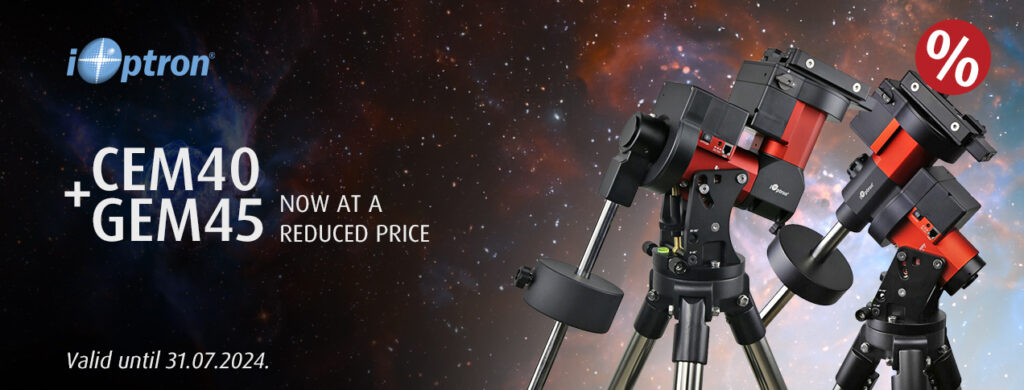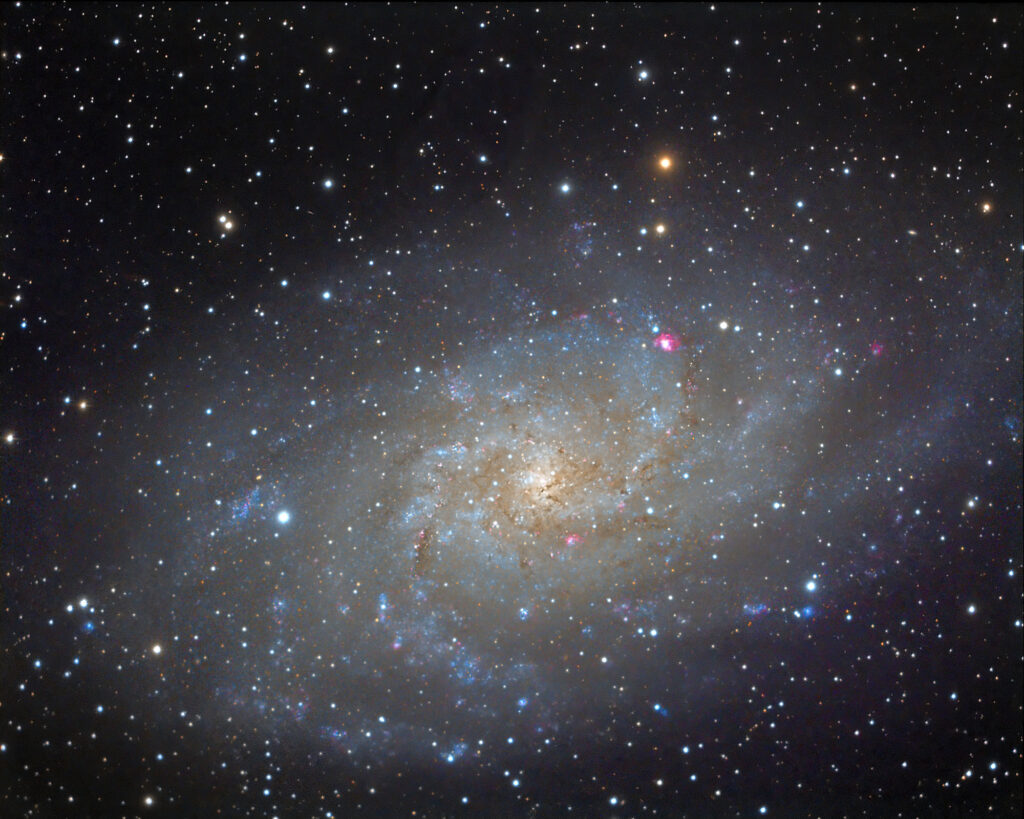Warm summer nights under a clear sky – this is not only a beautiful sight for amateur astronomers. Of course the nights are now particularly short, but even in the astronomically bright sky we can observe wonderful events. How about a first-class planetary meeting, a close encounter between Spica and the Moon and the long-awaited occultation of the planet Saturn by the Moon? We are certainly also looking forward to the shooting stars in August.
In the current infographic “Astrohighlights in Summer 2024” we have compiled the most beautiful celestial events.
Feel free to use the graphics on your website (with a link to www.astroshop.eu) and also inform your visitors about upcoming exciting events.
June
3.6. Mars meets the Moon
A celestial spectacle awaits early birds on June 3rd. As you look East at dawn, you will witness the reddish Mars and the thin crescent Moon forming a close conjunction – separated only by 2.6 degrees in the sky. This cosmic meeting is not only a fascinating sight, but also a great opportunity for astrophotography.
11.6. The Moon meets Regulus
A celestial view that looks almost royal can be admired tonight: The Moon joins Regulus, the bright main star of the constellation of Leo. The Moon will accompany the majestic lion for two more days, before continuing its journey and entering the next constellation.
16.6. Spica meets the Moon
On June 16th you can pay attention to a close meeting in the night sky between the Moon and Spica, the main star in Virgo. The two approach each other at a distance of only 0.25 degrees. Almost a “cosmic kiss” between these two celestial bodies. Spica, often occulted by the Moon, stays out of an occultation tonight. However, the short distance to the Moon offers an excellent opportunity for observers and photographers to capture this event. So get your telescopes and cameras ready!
27.6. The Moon meets Saturn
In the night of June 27th to 28th the Moon will be relatively close to Saturn. The Moon will approach the ringed planet during its journey and it will almost appear, as if our Moon is going to cover Saturn. From our latitude however, this phenomenon is not visible, as the Moon and Saturn are only visible after midnight. Unfortunately there is no occultation now – we have to wait a bit longer for such an event.
28.6. The Moon meets Neptune
While the rest of the World is still asleep in the early hours of June 28th, the Moon slowly moves towards Neptune – the distant gas giant on the outer edge of our Solar System. With a telescope we can try to catch a glimpse of this planet. Due to its great distance, it appears only as a small disk without recognizable details.
July
1.7. Comet 12P/Olbers
Comets are visitors to the inner Solar System before they disappear for a long time into the outer regions thereof. Once in a while it does happen that they are becoming really bright objects. This year we have already had the luck to observe the comet 12P/Pons-Brooks. In July a relatively bright comet can be seen in the sky: The comet 12P/Olbers. It will reach a brightness of 7.5 mag at the beginning of the month and can be seen with binoculars or a telescope. Unfortunately it is close to the horizon, thus making an observation not so easy. First you should find a location with a unobstructed view of the horizon. In addition, the horizon must be crystal clear, because even small or thin clouds can disturb the observation. If the conditions are good, you should definitely try to observe it!
2./3.7. The Moon meets Jupiter, Mars, Uranus and the Pleiades
The dawn of July 2nd and 3rd offers a beautiful celestial spectacle: The thin crescent Moon meets the planets Jupiter, Mars and Uranus during the night. All these objects are located near the famous Pleiades star cluster. This constellation offers an excellent opportunity for astrophotography in order to capture the meeting of these different celestial objects.
6.7. Ceres in opposition
In the night of July 6th Ceres, the largest dwarf planet in our Solar System, will reach its opposition point. This means that it appears to stand directly opposite to the Sun and is therefore visible all night long. With a brightness of 7.3 mag, Ceres is theoretically visible even with binoculars under favorable conditions, although a telescope is recommended for the observation. Due to its star-like appearance, it is necessary to use a star map to undoubtedly identify Ceres in the starry sky. Being without the distinctive features of a planet, the observation of Ceres requires careful planning and observation.
15.7. Mars meets Uranus
In the early morning of July 15th, it is worth looking at the sky when Mars passes by just below Uranus. The two planets will approach each other just shy of half a degree. This means they will appear in the same field of view in a telescope with a wide-angle (<65°) eyepiece. Have you seen this before? A good opportunity tonight. However, you may start observing only after 2 a.m. onwards. In the course of this night, both planets will rise higher in the sky, improving their visibility and observability.
23.7. Pluto in opposition
The dwarf planet with the big heart will be in opposition to the Sun today and will reach a brightness of 14.3 magnitudes. Therefore this former planet is only visible with large telescopes. It is however possible to image it with smaller telescopes. For the mere observation search charts are recommended.
30.7. Delta Aquarids
Watch out for the Delta Aquarids on July 30th. These meteors appear in the constellation of Aquarius and reach a maximum rate of 25 each per hour. The best time for observation is before midnight, as the Moon will appear above the horizon during the second half of the night. An interesting event for all who love shooting stars.
30.7. The Moon meets Mars, Jupiter, and Uranus
In the early morning of July 30th the Moon, Mars, and Jupiter can be observed in a striking constellation, close to the most famous star cluster – the Pleiades. Framed by the prominent stars Aldebaran and Capella, they create an impressive picture in the night sky. If you look into the sky at the beginning of dawn, you can really only admire this beautiful sight.
August
12.8. Perseids
A cosmic performance unfolds in the vast and rich nightsky of August: The Perseid meteor shower.
The Perseids, as they are called by astronomers, shoot numerous times across the sky this evening and we look up with anticipation. Perhaps we will discover bright examples that we can particularly enjoy.
The media often promises a “spectacular fireworks display of 100 shooting stars per hour, a true rain of shooting stars”. This is often an exaggeration, but even without exaggerating the Perseids can be a sensory and fascinating experience for us.
The Moon is now in its first quarter and will set before midnight. After that we can observe in darkness and undisturbed by stray light. All that’s missing is a comfortable blanket, a warm tea and friends who are enthusiastic about observing – so this evening may become a true success.
14.8. Mars meets Jupiter
In the early hours of August 14th a remarkable event will take place for observers, as Mars and Jupiter will approach each other at an extremely close distance of only 0.3 degrees. This short distance is extremely rare compared to the usual distances between planets in the sky and will appear almost, as if the two planets are touching. An ideal opportunity to grab binoculars or a telescope and observe the event. You can see both planets in one field of view, even at high magnification – a spectacular sight that does not happen very often.
21.8. The Moon covers Saturn
In the night of August 21st a very special spectacle presents itself: The Moon will cover the planet Saturn. Although the Moon and Saturn are already visible during the evening hours, the actual occultation does not occur until the early morning hours. At 5:32 a.m., when the Moon approaches Saturn from its illuminated side, the occultation begins. The ringed planet disappears behind the Moon for about an hour and then re-appears around 6:32 a.m. on the unilluminated side of the Moon. At that time the Moon will still be above the horizon, although the Sun will have already risen about 10 minutes earlier.
26.8. The Moon meets the Pleiades
On August 26th an interesting astronomical encounter will take place: The Moon will be in the famous Pleiades star cluster. Additionally, the Moon will move from the West towards the bright star Atlas and cover it in the early morning hours (from 5:40 a.m.). That is not all however, because in the constellation of Taurus there is still more to discover: If you look a little lower, you will find the planets Mars and Jupiter. The planet Uranus is in the same constellation as well, but since it is only visible with binoculars or a telescope, you will need a search chart.
27.8. The Moon meets Jupiter and Mars
In the night of August 27th it is worth looking again at Taurus, which appears above the horizon in the second half of the night. The constellation is accompanied by the planets Jupiter and Mars. Especially at early dawn, when the sky turns blueish, they form an incredibly beautiful trio together with the waning Moon.











